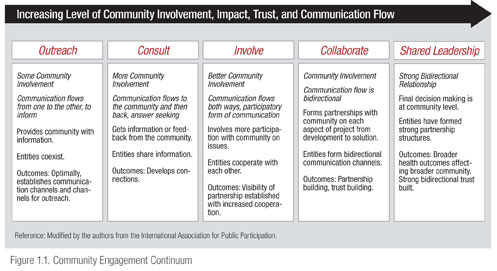What Is Community Engagement?

In the first edition of Principles, the authors developed a working definition of community engagement that captures its key features:
…the process of working collaboratively with and through groups of people affiliated by geographic proximity, special interest, or similar situations to address issues affecting the wellbeing of those people. It is a powerful vehicle for bringing about environmental and behavioral changes that will improve the health of the community and its members. It often involves partnerships and coalitions that help mobilize resources and influence systems, change relationships among partners, and serve as catalysts for changing policies, programs, and practices (CDC, 1997, p. 9).
Community engagement can take many forms, and partners can include organized groups, agencies, institutions, or individuals. Collaborators may be engaged in health promotion, research, or policy making.
Community engagement can also be seen as a continuum of community involvement. Figure 1.1 below, modified from a diagram originally drawn by the International Association for Public Participation, illustrates one way of thinking about such a continuum. Over time, a specific collaboration is likely to move along this continuum toward greater community involvement, and any given collaboration is likely to evolve in other ways, too. Most notably, while community engagement may be achieved during a timelimited project, it frequently involves — and often evolves into — long-term partnerships that move from the traditional focus on a single health issue to address a range of social, economic, political, and environmental factors that affect health.

Why Practice Community Engagement?
Advocates of community engagement assert that it improves health promotion and health research. However, the processes, costs, and benefits of community engagement are still a relatively new field of study. In 2004, AHRQ brought attention to the importance of empirical work in this area and greatly advanced our knowledge through a synthesis of the research, much of which indicated that community engagement strengthened the conduct of research (Viswanathan et al., 2004).
A recent review of the literature on community engagement identified nine areas in which community engagement made a positive impact (Staley, 2009). Although this study focused on research partnerships, many of its findings are relevant to community engagement in general. The nine areas and the corresponding benefits were as follows:
- Agenda—Engagement changes the choice and focus of projects, how they are initiated, and their potential to obtain funding. New areas for collaboration are identified, and funding that requires community engagement becomes accessible.
- Design and delivery—Improvements to study design, tools, interventions, representation/participation, data collection and analysis, communication, and dissemination can be implemented. New interventions or previously unappreciated causal links can be identified through the community’s knowledge of local circumstances. The speed and efficiency of the project can be enhanced by rapidly engaging partners and participants and identifying new sources of information.
- Implementation and change—Improvements can be made in the way research findings are used to bring about change (e.g., through new or improved services, policy or funding changes, or transformation of professional practices), and capacity for change and the maintenance of long-term partnerships can be expanded.
- Ethics—Engagement creates opportunities to improve the consent process, identify ethical pitfalls, and create processes for resolving ethical problems when they arise.
- The public involved in the project—The knowledge and skills of the public involved in the project can be enhanced, and their contributions can be recognized (possibly through financial rewards). These efforts foster goodwill and help lay the groundwork for subsequent collaborations.
- Academic partners—Academic partners can gain enhanced understanding of the issue under study and appreciation of the role and value of community involvement, which sometimes result in direct career benefits. In addition, new insights into the relevance of a project and the various benefits to be gained from it can result in increased opportunities to disseminate its findings and their wider use.
- Individual research participants—Improvements in the way studies are carried out can make it easier to participate in them and bring benefits to participants.
- Community organizations—These organizations can gain enhanced knowledge, a higher profile in the community, more linkages with other community members and entities, and new organizational capacity. These benefits can create goodwill and help lay the groundwork for subsequent collaborations.
- The general public—The general public is likely to be more receptive to the research and reap greater benefits from it.
The author of the review acknowledged that there can be costs associated with community engagement (e.g., increased time and other resource needs, the need to develop new skill sets, increased expectations) but contended that these are more than outweighed by the positive impacts and generally can be addressed over time through training and experience (Staley, 2009).
- Page last reviewed: June 25, 2015
- Page last updated: August 1, 2011
- Content source:



 ShareCompartir
ShareCompartir